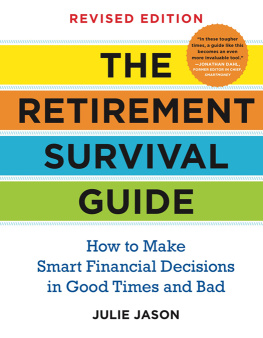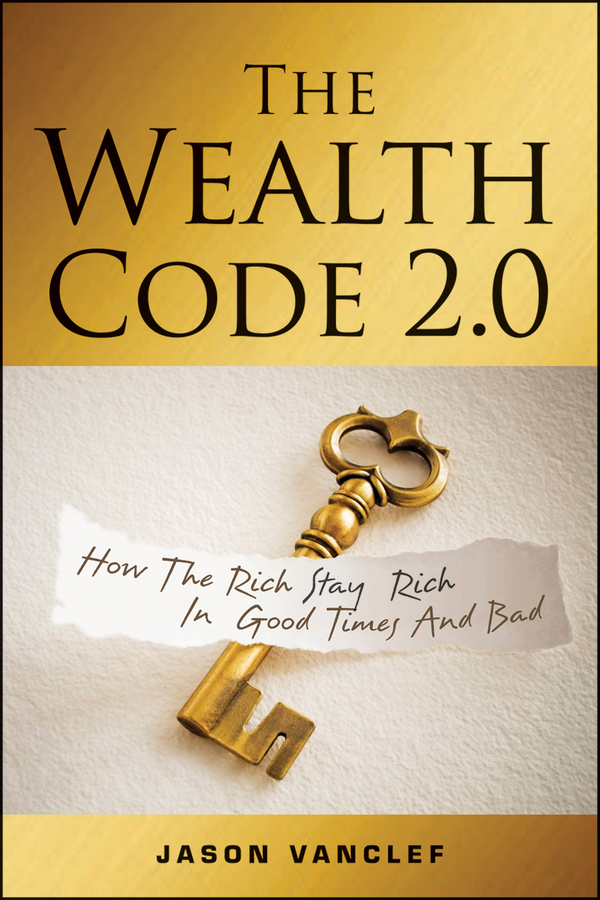Contents

Cover image: Key, Sarah Lee / iStockphoto, gold background,
Gyro Photography/amanaimagesRF / Getty Images.
Cover design: Leiva-Sposato.
Copyright 2013 by Jason Vanclef. All rights reserved.
Published by John Wiley & Sons, Inc., Hoboken, New Jersey.
The first edition of The Wealth Code was published by Createspace in 2009.
Published simultaneously in Canada.
No part of this publication may be reproduced, stored in a retrieval system, or transmitted in any form or by any means, electronic, mechanical, photocopying, recording, scanning, or otherwise, except as permitted under Section 107 or 108 of the 1976 United States Copyright Act, without either the prior written permission of the Publisher, or authorization through payment of the appropriate per-copy fee to the Copyright Clearance Center, Inc., 222 Rosewood Drive, Danvers, MA 01923, (978) 750-8400, fax (978) 646-8600, or on the Web at www.copyright.com . Requests to the Publisher for permission should be addressed to the Permissions Department, John Wiley & Sons, Inc., 111 River Street, Hoboken, NJ 07030, (201) 748-6011, fax (201) 748-6008, or online at http://www.wiley.com/go/permissions .
Limit of Liability/Disclaimer of Warranty: While the publisher and author have used their best efforts in preparing this book, they make no representations or warranties with respect to the accuracy or completeness of the contents of this book and specifically disclaim any implied warranties of merchantability or fitness for a particular purpose. No warranty may be created or extended by sales representatives or written sales materials. The advice and strategies contained herein may not be suitable for your situation. You should consult with a professional where appropriate. Neither the publisher nor author shall be liable for any loss of profit or any other commercial damages, including but not limited to special, incidental, consequential, or other damages.
For general information on our other products and services or for technical support, please contact our Customer Care Department within the United States at (800) 762-2974, outside the United States at (317) 572-3993, or fax (317) 572-4002.
Wiley publishes in a variety of print and electronic formats and by print-on-demand. Some material included with standard print versions of this book may not be included in e-books or in print-on-demand. If this book refers to media such as a CD or DVD that is not included in the version you purchased, you may download this material at http://booksupport.wiley.com . For more information about Wiley products, visit www.wiley.com .
ISBN 978-1-118-48336-7 (Hardcover); ISBN 978-1-118-48390-9 (ebk);
ISBN 978-1-118-48387-9 (ebk); ISBN 978-1-118-48381-7 (ebk)
For Tami, Grant, and Cole. You inspire me every minute of the day to be a better man .
Jason/Dad
Preface
A frog placed in a pot of boiling water will jump out and save itself. If that same frog is placed in the pot with cold water and heat is slowly applied, it will boil itself to death.
Running a wealth management firm in Los Angeles, California, I meet hundreds of people each year and discuss their finances. Nothing cuts more to the core than people and their money. With each passing year, as I see hard working people who have had their retirement goals shattered time and time again by the stock markets. I question, Is the stock market just a big pot of water with the heat slowly being turned on?
If this book was written in a year like 1999 or 2006, most people would disregard it. The stock markets are great, they would say. It has made us a lot of money. In spite of the terrible correction between 2000 and 2002, the sense that all was right was the prevailing belief. By 2006 most people were nowhere near the account value they had before the market crash, yet their faith in the market was unshakable. The heat was being applied to the pot of water, but most people stayed the course.
The timing of the first edition of The Wealth Code , mid 2009 and after the horrendous loss of wealth suffered with the stock market crash between 2007 and 2009, was no accident. I felt people needed to be shaken up before they could be open to a different viewpoint on building and protecting their nest eggs.
My goal was to educate investors on how using financial building blocks other than just stocks and bonds could provide the potential for more consistent returns and cash flow for their retirements. These other building blocks include investments such as Oil/Gas, Equipment Leases, Collateralized Notes, Real Estate, and many more. Financial ideas common to the super wealthy but generally not thought of as being accessible to the regular investor in a 401(k) plan or in their personal savings.
Representing ideas of wealth, not Wall Street, has been a common saying to my clients for years now.
The objective of this second edition is to further expand the ideas, applying lessons learned in the last three years since the first edition was published, and more importantly to give people a new perspective and more control over their finances. After experiencing 12 years in the current bear market which began in 2000, most people are beginning to realize that maybe the water pot is not the best place for their money, and the revolt against staying the course has begun.
Jason Vanclef
December 2012
Acknowledgments
A few people are directly responsible for making this book a reality. First, Nancy and Herve Vanclef, mom and dad, who had a huge impact on editing this book and smoothing out the rough edges. Your contributions and ideas sorted out my 2 A.M. feverish writings and made them coherent. You were the perfect sounding board to bounce ideas off. To my brother Cristian who from afar has always demonstrated to me that genius is often found in overlooked places. R.D. Hutchinson, Sr., my grandfather, who was the inspiration for my entire career as a financial advisor.
I also want to recognize Mark Trewitt for his contributions on the topic of discounted Roth IRA conversions. As a financial adviser you represent the epitome of excellence and Im proud to work with you in our quest to improve peoples retirements and lives.
Lastly, I want to thank all my clients who have constantly inspired me to grow and adapt in this ever-changing economic landscape. This book is dedicated to you.
For referrals to advisers who practice the concepts in The Wealth Code, go to www.TheWealthCode.com .
Introduction
If what you thought to be true turned out NOT to be true, when would you want to know?
Imagine you are on a gurney and they are wheeling you into surgery. You were out hiking in the woods, got caught in a freak snowstorm, and ended up with frostbite on your left big toe. In order to save your left foot, they have to amputate the left big toe.
Under the intense lights, as the anesthesiologist is about to knock you out, you happen to look over and see the instruction sheet to the surgeons for this operation. Much to your horror, someone has mistakenly written incorrect instructions. They read, Amputate the RIGHT big toe.
The doctors are just about to knock you out. Would you agree you are at a juncture in your life?
What do you do? Do you scream bloody murder or rationalize to yourself, No, these doctors are smart; they would never cut off the wrong toe. They know what they are doing . Do you go to sleep hoping for the best?
Hopefully, you choose the option to scream bloody murder. If you choose hope for the best and wake up after surgery with your right toe gone, it will only add insult to injury, since they still have to amputate the left big toe.








